An Investigation into Leadership in Apollo 13: Project Management
VerifiedAdded on 2021/03/01
|12
|3396
|51
Essay
AI Summary
This essay investigates leadership, management, and people development in the context of project management, using the Apollo 13 movie as a case study. The essay begins with an overview of leadership concepts, tracing the evolution of leadership theories from 'great man' and trait theories to situational, contingency, transactional, and transformational leadership. The core of the essay analyzes the leadership styles of Gene Kranz and Jim Lovell during the Apollo 13 mission, applying Fiedler's Contingency Theory and Path-Goal Theory to evaluate their effectiveness in a crisis situation. The analysis examines how Kranz and Lovell adapted their leadership approaches to meet the unique challenges of the mission, focusing on their ability to motivate, direct, and manage their teams under extreme pressure. The essay concludes by summarizing the key leadership lessons learned from the Apollo 13 mission, highlighting the importance of adaptable leadership, effective communication, and teamwork in achieving project goals, even in the face of unexpected adversity. The essay emphasizes the importance of leadership styles in project management and how these styles can have a huge impact on the project's success.
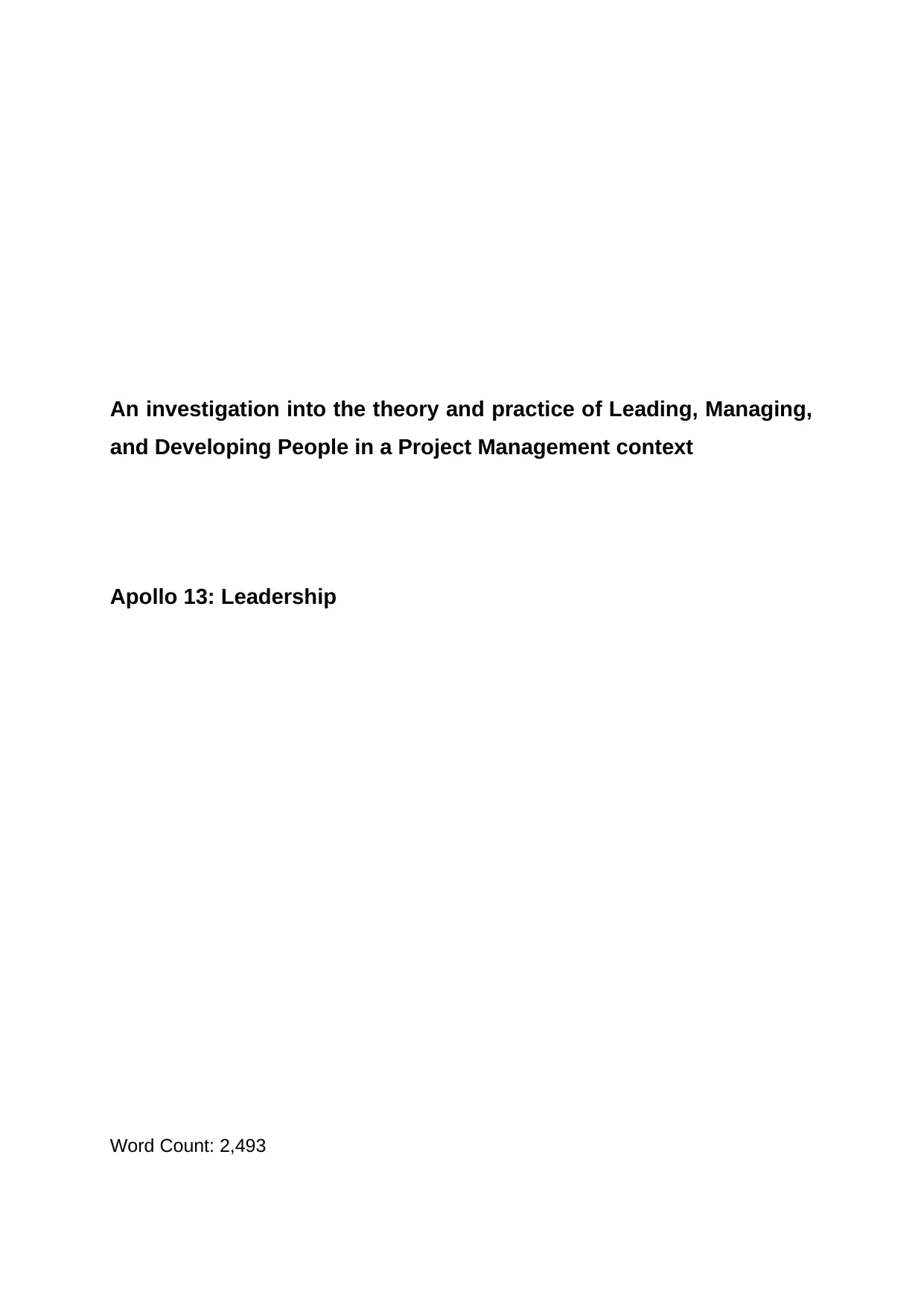
An investigation into the theory and practice of Leading, Managing,
and Developing People in a Project Management context
Apollo 13: Leadership
Word Count: 2,493
and Developing People in a Project Management context
Apollo 13: Leadership
Word Count: 2,493
Paraphrase This Document
Need a fresh take? Get an instant paraphrase of this document with our AI Paraphraser
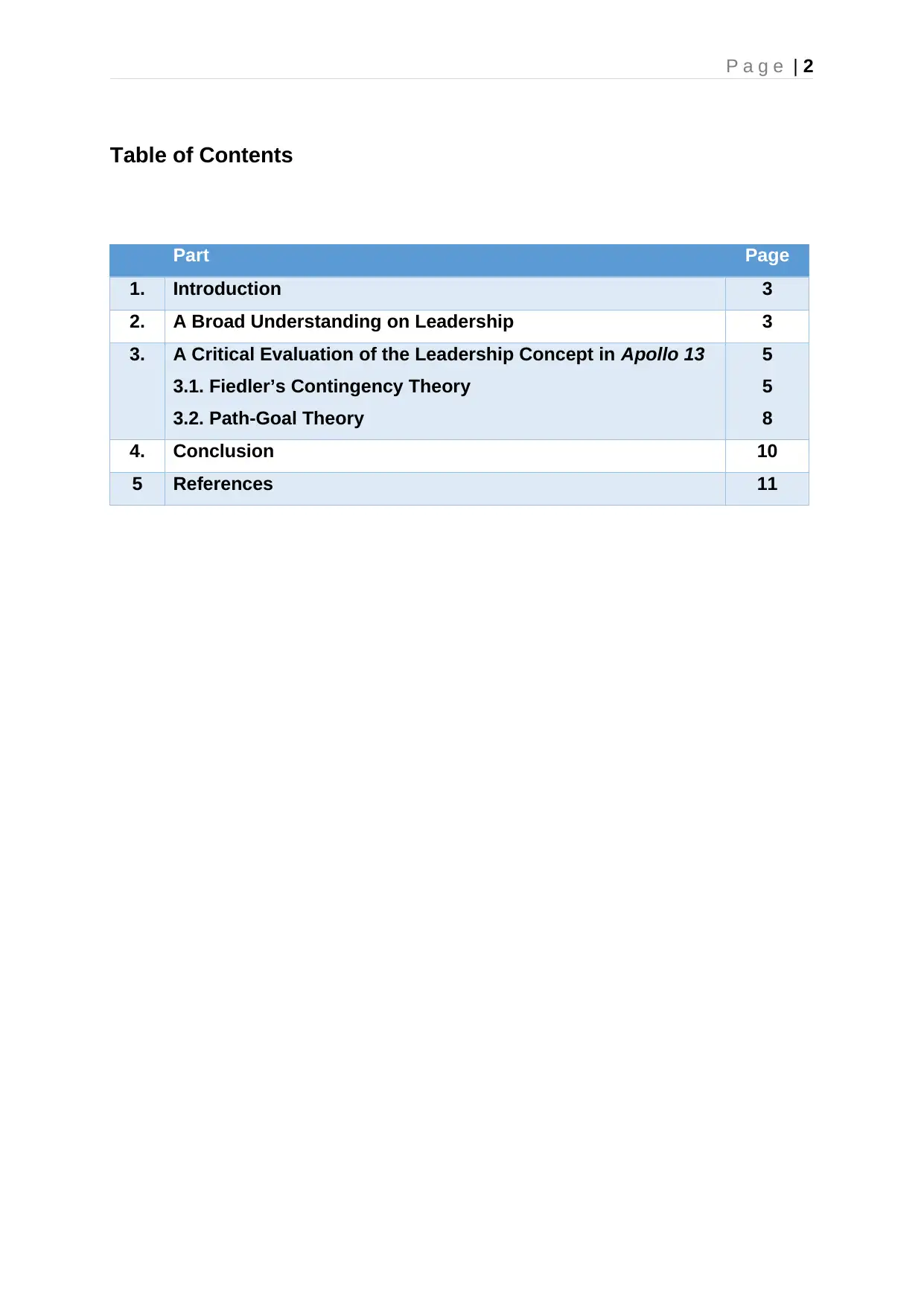
P a g e | 2
Table of Contents
Part Page
1. Introduction 3
2. A Broad Understanding on Leadership 3
3. A Critical Evaluation of the Leadership Concept in Apollo 13
3.1. Fiedler’s Contingency Theory
3.2. Path-Goal Theory
5
5
8
4. Conclusion 10
5 References 11
Table of Contents
Part Page
1. Introduction 3
2. A Broad Understanding on Leadership 3
3. A Critical Evaluation of the Leadership Concept in Apollo 13
3.1. Fiedler’s Contingency Theory
3.2. Path-Goal Theory
5
5
8
4. Conclusion 10
5 References 11
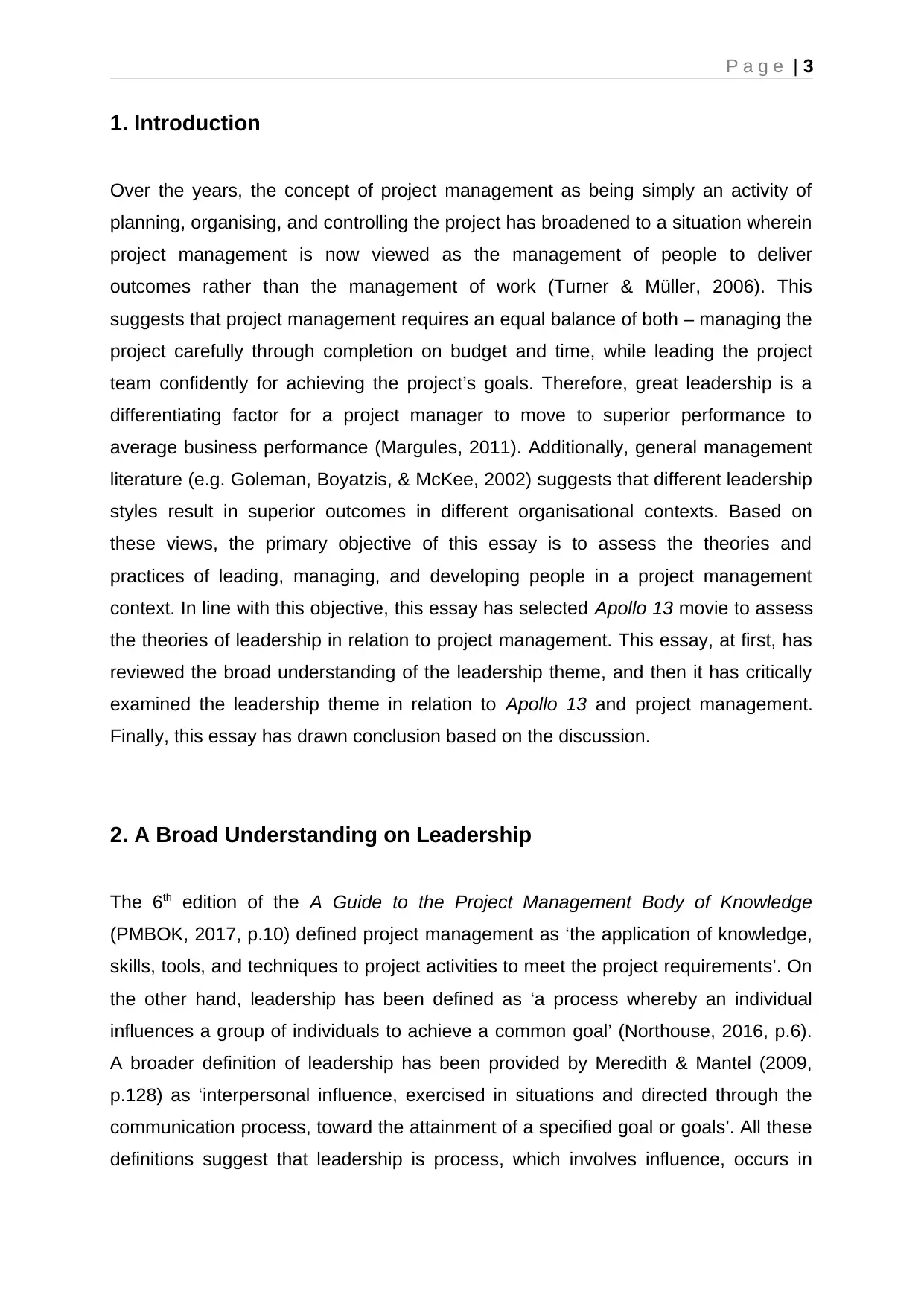
P a g e | 3
1. Introduction
Over the years, the concept of project management as being simply an activity of
planning, organising, and controlling the project has broadened to a situation wherein
project management is now viewed as the management of people to deliver
outcomes rather than the management of work (Turner & Müller, 2006). This
suggests that project management requires an equal balance of both – managing the
project carefully through completion on budget and time, while leading the project
team confidently for achieving the project’s goals. Therefore, great leadership is a
differentiating factor for a project manager to move to superior performance to
average business performance (Margules, 2011). Additionally, general management
literature (e.g. Goleman, Boyatzis, & McKee, 2002) suggests that different leadership
styles result in superior outcomes in different organisational contexts. Based on
these views, the primary objective of this essay is to assess the theories and
practices of leading, managing, and developing people in a project management
context. In line with this objective, this essay has selected Apollo 13 movie to assess
the theories of leadership in relation to project management. This essay, at first, has
reviewed the broad understanding of the leadership theme, and then it has critically
examined the leadership theme in relation to Apollo 13 and project management.
Finally, this essay has drawn conclusion based on the discussion.
2. A Broad Understanding on Leadership
The 6th edition of the A Guide to the Project Management Body of Knowledge
(PMBOK, 2017, p.10) defined project management as ‘the application of knowledge,
skills, tools, and techniques to project activities to meet the project requirements’. On
the other hand, leadership has been defined as ‘a process whereby an individual
influences a group of individuals to achieve a common goal’ (Northouse, 2016, p.6).
A broader definition of leadership has been provided by Meredith & Mantel (2009,
p.128) as ‘interpersonal influence, exercised in situations and directed through the
communication process, toward the attainment of a specified goal or goals’. All these
definitions suggest that leadership is process, which involves influence, occurs in
1. Introduction
Over the years, the concept of project management as being simply an activity of
planning, organising, and controlling the project has broadened to a situation wherein
project management is now viewed as the management of people to deliver
outcomes rather than the management of work (Turner & Müller, 2006). This
suggests that project management requires an equal balance of both – managing the
project carefully through completion on budget and time, while leading the project
team confidently for achieving the project’s goals. Therefore, great leadership is a
differentiating factor for a project manager to move to superior performance to
average business performance (Margules, 2011). Additionally, general management
literature (e.g. Goleman, Boyatzis, & McKee, 2002) suggests that different leadership
styles result in superior outcomes in different organisational contexts. Based on
these views, the primary objective of this essay is to assess the theories and
practices of leading, managing, and developing people in a project management
context. In line with this objective, this essay has selected Apollo 13 movie to assess
the theories of leadership in relation to project management. This essay, at first, has
reviewed the broad understanding of the leadership theme, and then it has critically
examined the leadership theme in relation to Apollo 13 and project management.
Finally, this essay has drawn conclusion based on the discussion.
2. A Broad Understanding on Leadership
The 6th edition of the A Guide to the Project Management Body of Knowledge
(PMBOK, 2017, p.10) defined project management as ‘the application of knowledge,
skills, tools, and techniques to project activities to meet the project requirements’. On
the other hand, leadership has been defined as ‘a process whereby an individual
influences a group of individuals to achieve a common goal’ (Northouse, 2016, p.6).
A broader definition of leadership has been provided by Meredith & Mantel (2009,
p.128) as ‘interpersonal influence, exercised in situations and directed through the
communication process, toward the attainment of a specified goal or goals’. All these
definitions suggest that leadership is process, which involves influence, occurs in
⊘ This is a preview!⊘
Do you want full access?
Subscribe today to unlock all pages.

Trusted by 1+ million students worldwide
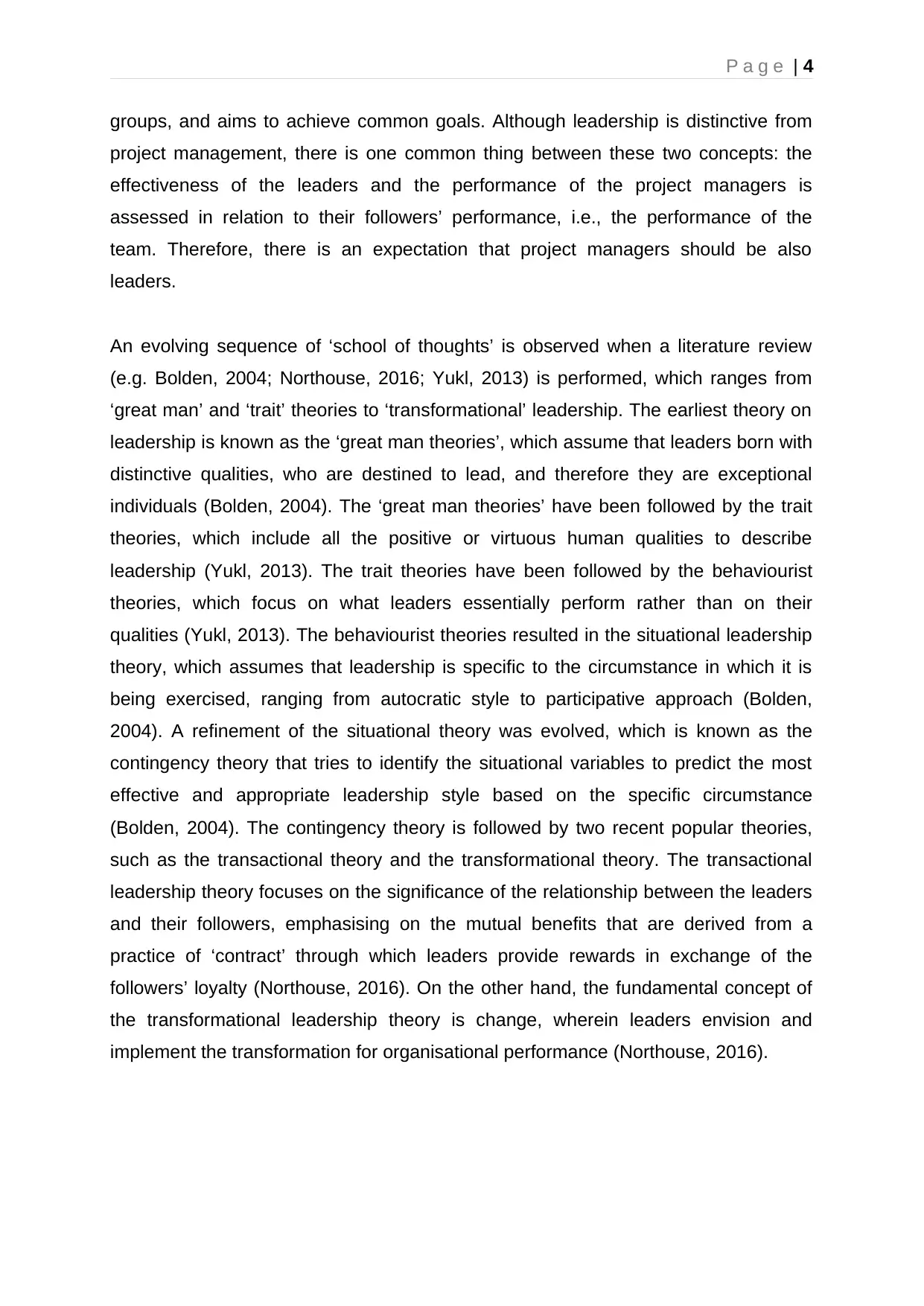
P a g e | 4
groups, and aims to achieve common goals. Although leadership is distinctive from
project management, there is one common thing between these two concepts: the
effectiveness of the leaders and the performance of the project managers is
assessed in relation to their followers’ performance, i.e., the performance of the
team. Therefore, there is an expectation that project managers should be also
leaders.
An evolving sequence of ‘school of thoughts’ is observed when a literature review
(e.g. Bolden, 2004; Northouse, 2016; Yukl, 2013) is performed, which ranges from
‘great man’ and ‘trait’ theories to ‘transformational’ leadership. The earliest theory on
leadership is known as the ‘great man theories’, which assume that leaders born with
distinctive qualities, who are destined to lead, and therefore they are exceptional
individuals (Bolden, 2004). The ‘great man theories’ have been followed by the trait
theories, which include all the positive or virtuous human qualities to describe
leadership (Yukl, 2013). The trait theories have been followed by the behaviourist
theories, which focus on what leaders essentially perform rather than on their
qualities (Yukl, 2013). The behaviourist theories resulted in the situational leadership
theory, which assumes that leadership is specific to the circumstance in which it is
being exercised, ranging from autocratic style to participative approach (Bolden,
2004). A refinement of the situational theory was evolved, which is known as the
contingency theory that tries to identify the situational variables to predict the most
effective and appropriate leadership style based on the specific circumstance
(Bolden, 2004). The contingency theory is followed by two recent popular theories,
such as the transactional theory and the transformational theory. The transactional
leadership theory focuses on the significance of the relationship between the leaders
and their followers, emphasising on the mutual benefits that are derived from a
practice of ‘contract’ through which leaders provide rewards in exchange of the
followers’ loyalty (Northouse, 2016). On the other hand, the fundamental concept of
the transformational leadership theory is change, wherein leaders envision and
implement the transformation for organisational performance (Northouse, 2016).
groups, and aims to achieve common goals. Although leadership is distinctive from
project management, there is one common thing between these two concepts: the
effectiveness of the leaders and the performance of the project managers is
assessed in relation to their followers’ performance, i.e., the performance of the
team. Therefore, there is an expectation that project managers should be also
leaders.
An evolving sequence of ‘school of thoughts’ is observed when a literature review
(e.g. Bolden, 2004; Northouse, 2016; Yukl, 2013) is performed, which ranges from
‘great man’ and ‘trait’ theories to ‘transformational’ leadership. The earliest theory on
leadership is known as the ‘great man theories’, which assume that leaders born with
distinctive qualities, who are destined to lead, and therefore they are exceptional
individuals (Bolden, 2004). The ‘great man theories’ have been followed by the trait
theories, which include all the positive or virtuous human qualities to describe
leadership (Yukl, 2013). The trait theories have been followed by the behaviourist
theories, which focus on what leaders essentially perform rather than on their
qualities (Yukl, 2013). The behaviourist theories resulted in the situational leadership
theory, which assumes that leadership is specific to the circumstance in which it is
being exercised, ranging from autocratic style to participative approach (Bolden,
2004). A refinement of the situational theory was evolved, which is known as the
contingency theory that tries to identify the situational variables to predict the most
effective and appropriate leadership style based on the specific circumstance
(Bolden, 2004). The contingency theory is followed by two recent popular theories,
such as the transactional theory and the transformational theory. The transactional
leadership theory focuses on the significance of the relationship between the leaders
and their followers, emphasising on the mutual benefits that are derived from a
practice of ‘contract’ through which leaders provide rewards in exchange of the
followers’ loyalty (Northouse, 2016). On the other hand, the fundamental concept of
the transformational leadership theory is change, wherein leaders envision and
implement the transformation for organisational performance (Northouse, 2016).
Paraphrase This Document
Need a fresh take? Get an instant paraphrase of this document with our AI Paraphraser
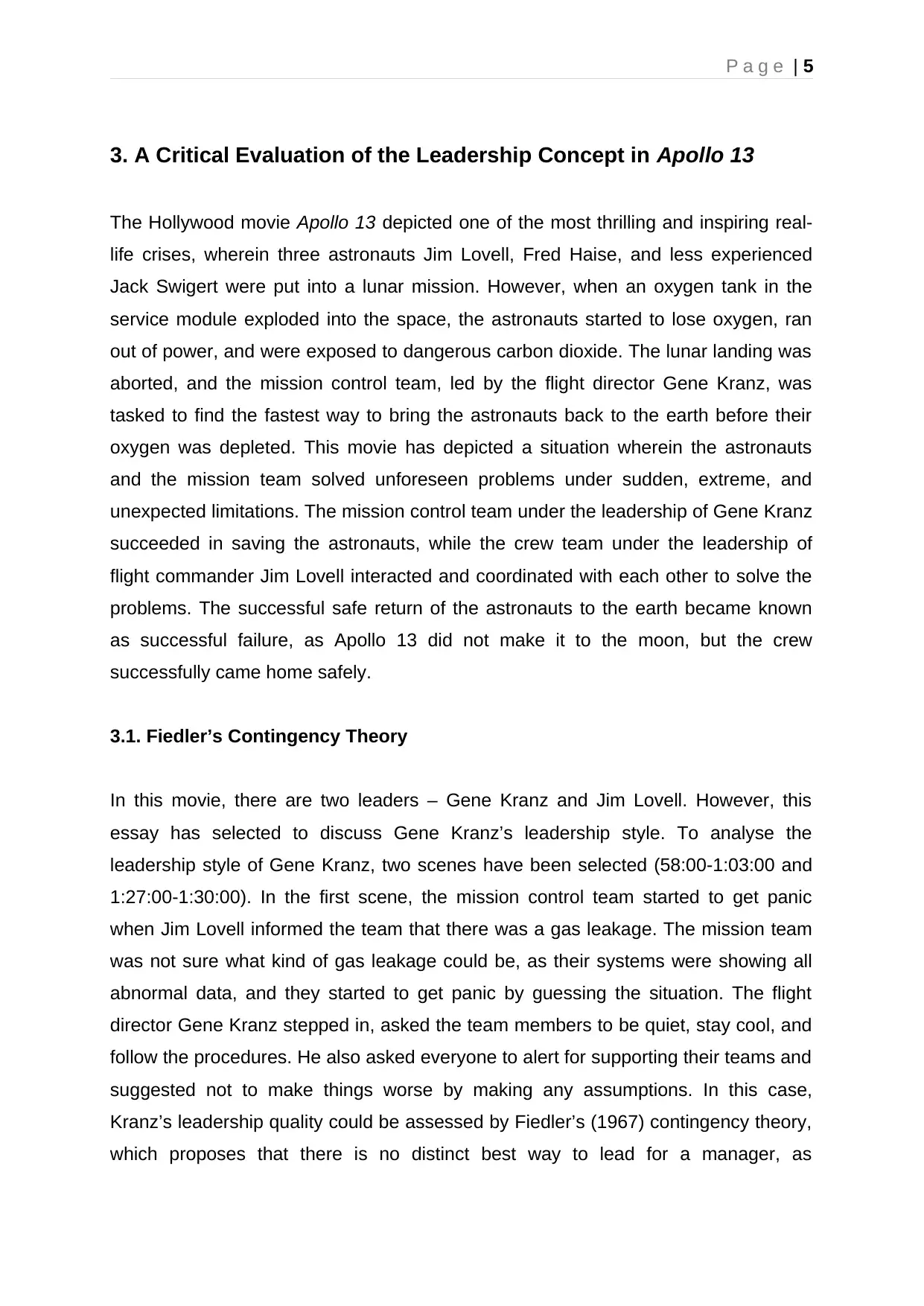
P a g e | 5
3. A Critical Evaluation of the Leadership Concept in Apollo 13
The Hollywood movie Apollo 13 depicted one of the most thrilling and inspiring real-
life crises, wherein three astronauts Jim Lovell, Fred Haise, and less experienced
Jack Swigert were put into a lunar mission. However, when an oxygen tank in the
service module exploded into the space, the astronauts started to lose oxygen, ran
out of power, and were exposed to dangerous carbon dioxide. The lunar landing was
aborted, and the mission control team, led by the flight director Gene Kranz, was
tasked to find the fastest way to bring the astronauts back to the earth before their
oxygen was depleted. This movie has depicted a situation wherein the astronauts
and the mission team solved unforeseen problems under sudden, extreme, and
unexpected limitations. The mission control team under the leadership of Gene Kranz
succeeded in saving the astronauts, while the crew team under the leadership of
flight commander Jim Lovell interacted and coordinated with each other to solve the
problems. The successful safe return of the astronauts to the earth became known
as successful failure, as Apollo 13 did not make it to the moon, but the crew
successfully came home safely.
3.1. Fiedler’s Contingency Theory
In this movie, there are two leaders – Gene Kranz and Jim Lovell. However, this
essay has selected to discuss Gene Kranz’s leadership style. To analyse the
leadership style of Gene Kranz, two scenes have been selected (58:00-1:03:00 and
1:27:00-1:30:00). In the first scene, the mission control team started to get panic
when Jim Lovell informed the team that there was a gas leakage. The mission team
was not sure what kind of gas leakage could be, as their systems were showing all
abnormal data, and they started to get panic by guessing the situation. The flight
director Gene Kranz stepped in, asked the team members to be quiet, stay cool, and
follow the procedures. He also asked everyone to alert for supporting their teams and
suggested not to make things worse by making any assumptions. In this case,
Kranz’s leadership quality could be assessed by Fiedler’s (1967) contingency theory,
which proposes that there is no distinct best way to lead for a manager, as
3. A Critical Evaluation of the Leadership Concept in Apollo 13
The Hollywood movie Apollo 13 depicted one of the most thrilling and inspiring real-
life crises, wherein three astronauts Jim Lovell, Fred Haise, and less experienced
Jack Swigert were put into a lunar mission. However, when an oxygen tank in the
service module exploded into the space, the astronauts started to lose oxygen, ran
out of power, and were exposed to dangerous carbon dioxide. The lunar landing was
aborted, and the mission control team, led by the flight director Gene Kranz, was
tasked to find the fastest way to bring the astronauts back to the earth before their
oxygen was depleted. This movie has depicted a situation wherein the astronauts
and the mission team solved unforeseen problems under sudden, extreme, and
unexpected limitations. The mission control team under the leadership of Gene Kranz
succeeded in saving the astronauts, while the crew team under the leadership of
flight commander Jim Lovell interacted and coordinated with each other to solve the
problems. The successful safe return of the astronauts to the earth became known
as successful failure, as Apollo 13 did not make it to the moon, but the crew
successfully came home safely.
3.1. Fiedler’s Contingency Theory
In this movie, there are two leaders – Gene Kranz and Jim Lovell. However, this
essay has selected to discuss Gene Kranz’s leadership style. To analyse the
leadership style of Gene Kranz, two scenes have been selected (58:00-1:03:00 and
1:27:00-1:30:00). In the first scene, the mission control team started to get panic
when Jim Lovell informed the team that there was a gas leakage. The mission team
was not sure what kind of gas leakage could be, as their systems were showing all
abnormal data, and they started to get panic by guessing the situation. The flight
director Gene Kranz stepped in, asked the team members to be quiet, stay cool, and
follow the procedures. He also asked everyone to alert for supporting their teams and
suggested not to make things worse by making any assumptions. In this case,
Kranz’s leadership quality could be assessed by Fiedler’s (1967) contingency theory,
which proposes that there is no distinct best way to lead for a manager, as
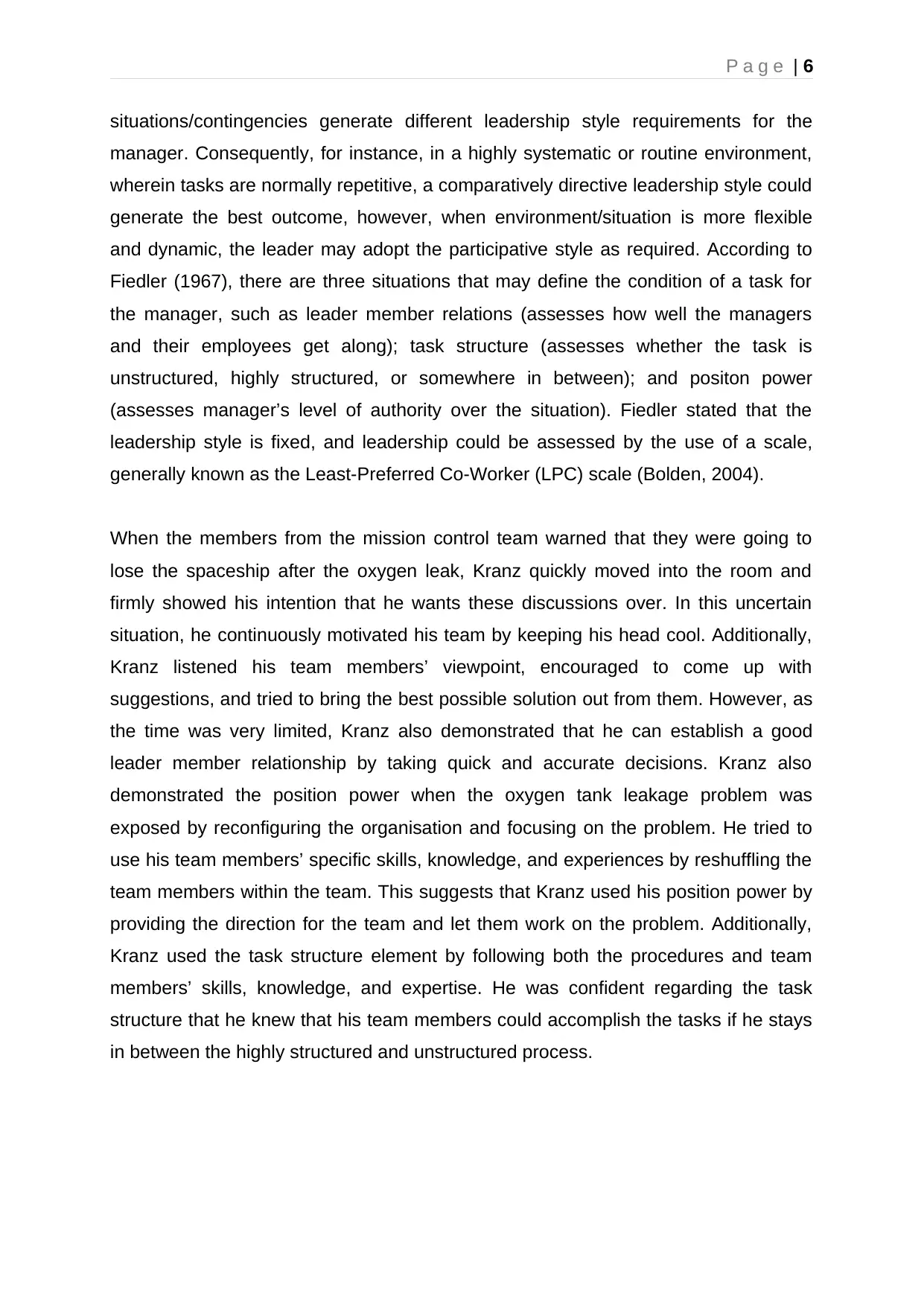
P a g e | 6
situations/contingencies generate different leadership style requirements for the
manager. Consequently, for instance, in a highly systematic or routine environment,
wherein tasks are normally repetitive, a comparatively directive leadership style could
generate the best outcome, however, when environment/situation is more flexible
and dynamic, the leader may adopt the participative style as required. According to
Fiedler (1967), there are three situations that may define the condition of a task for
the manager, such as leader member relations (assesses how well the managers
and their employees get along); task structure (assesses whether the task is
unstructured, highly structured, or somewhere in between); and positon power
(assesses manager’s level of authority over the situation). Fiedler stated that the
leadership style is fixed, and leadership could be assessed by the use of a scale,
generally known as the Least-Preferred Co-Worker (LPC) scale (Bolden, 2004).
When the members from the mission control team warned that they were going to
lose the spaceship after the oxygen leak, Kranz quickly moved into the room and
firmly showed his intention that he wants these discussions over. In this uncertain
situation, he continuously motivated his team by keeping his head cool. Additionally,
Kranz listened his team members’ viewpoint, encouraged to come up with
suggestions, and tried to bring the best possible solution out from them. However, as
the time was very limited, Kranz also demonstrated that he can establish a good
leader member relationship by taking quick and accurate decisions. Kranz also
demonstrated the position power when the oxygen tank leakage problem was
exposed by reconfiguring the organisation and focusing on the problem. He tried to
use his team members’ specific skills, knowledge, and experiences by reshuffling the
team members within the team. This suggests that Kranz used his position power by
providing the direction for the team and let them work on the problem. Additionally,
Kranz used the task structure element by following both the procedures and team
members’ skills, knowledge, and expertise. He was confident regarding the task
structure that he knew that his team members could accomplish the tasks if he stays
in between the highly structured and unstructured process.
situations/contingencies generate different leadership style requirements for the
manager. Consequently, for instance, in a highly systematic or routine environment,
wherein tasks are normally repetitive, a comparatively directive leadership style could
generate the best outcome, however, when environment/situation is more flexible
and dynamic, the leader may adopt the participative style as required. According to
Fiedler (1967), there are three situations that may define the condition of a task for
the manager, such as leader member relations (assesses how well the managers
and their employees get along); task structure (assesses whether the task is
unstructured, highly structured, or somewhere in between); and positon power
(assesses manager’s level of authority over the situation). Fiedler stated that the
leadership style is fixed, and leadership could be assessed by the use of a scale,
generally known as the Least-Preferred Co-Worker (LPC) scale (Bolden, 2004).
When the members from the mission control team warned that they were going to
lose the spaceship after the oxygen leak, Kranz quickly moved into the room and
firmly showed his intention that he wants these discussions over. In this uncertain
situation, he continuously motivated his team by keeping his head cool. Additionally,
Kranz listened his team members’ viewpoint, encouraged to come up with
suggestions, and tried to bring the best possible solution out from them. However, as
the time was very limited, Kranz also demonstrated that he can establish a good
leader member relationship by taking quick and accurate decisions. Kranz also
demonstrated the position power when the oxygen tank leakage problem was
exposed by reconfiguring the organisation and focusing on the problem. He tried to
use his team members’ specific skills, knowledge, and experiences by reshuffling the
team members within the team. This suggests that Kranz used his position power by
providing the direction for the team and let them work on the problem. Additionally,
Kranz used the task structure element by following both the procedures and team
members’ skills, knowledge, and expertise. He was confident regarding the task
structure that he knew that his team members could accomplish the tasks if he stays
in between the highly structured and unstructured process.
⊘ This is a preview!⊘
Do you want full access?
Subscribe today to unlock all pages.

Trusted by 1+ million students worldwide
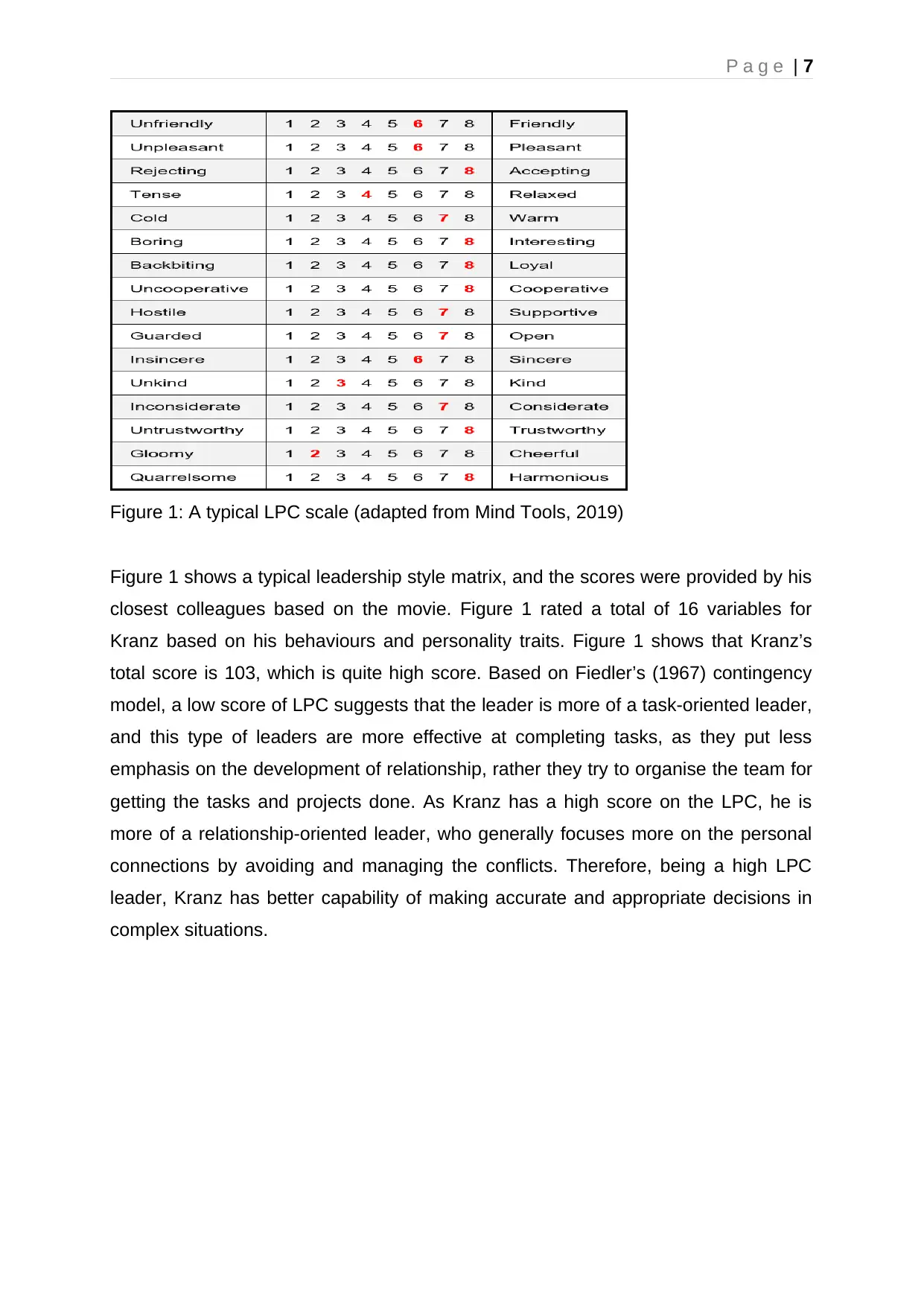
P a g e | 7
Figure 1: A typical LPC scale (adapted from Mind Tools, 2019)
Figure 1 shows a typical leadership style matrix, and the scores were provided by his
closest colleagues based on the movie. Figure 1 rated a total of 16 variables for
Kranz based on his behaviours and personality traits. Figure 1 shows that Kranz’s
total score is 103, which is quite high score. Based on Fiedler’s (1967) contingency
model, a low score of LPC suggests that the leader is more of a task-oriented leader,
and this type of leaders are more effective at completing tasks, as they put less
emphasis on the development of relationship, rather they try to organise the team for
getting the tasks and projects done. As Kranz has a high score on the LPC, he is
more of a relationship-oriented leader, who generally focuses more on the personal
connections by avoiding and managing the conflicts. Therefore, being a high LPC
leader, Kranz has better capability of making accurate and appropriate decisions in
complex situations.
Figure 1: A typical LPC scale (adapted from Mind Tools, 2019)
Figure 1 shows a typical leadership style matrix, and the scores were provided by his
closest colleagues based on the movie. Figure 1 rated a total of 16 variables for
Kranz based on his behaviours and personality traits. Figure 1 shows that Kranz’s
total score is 103, which is quite high score. Based on Fiedler’s (1967) contingency
model, a low score of LPC suggests that the leader is more of a task-oriented leader,
and this type of leaders are more effective at completing tasks, as they put less
emphasis on the development of relationship, rather they try to organise the team for
getting the tasks and projects done. As Kranz has a high score on the LPC, he is
more of a relationship-oriented leader, who generally focuses more on the personal
connections by avoiding and managing the conflicts. Therefore, being a high LPC
leader, Kranz has better capability of making accurate and appropriate decisions in
complex situations.
Paraphrase This Document
Need a fresh take? Get an instant paraphrase of this document with our AI Paraphraser
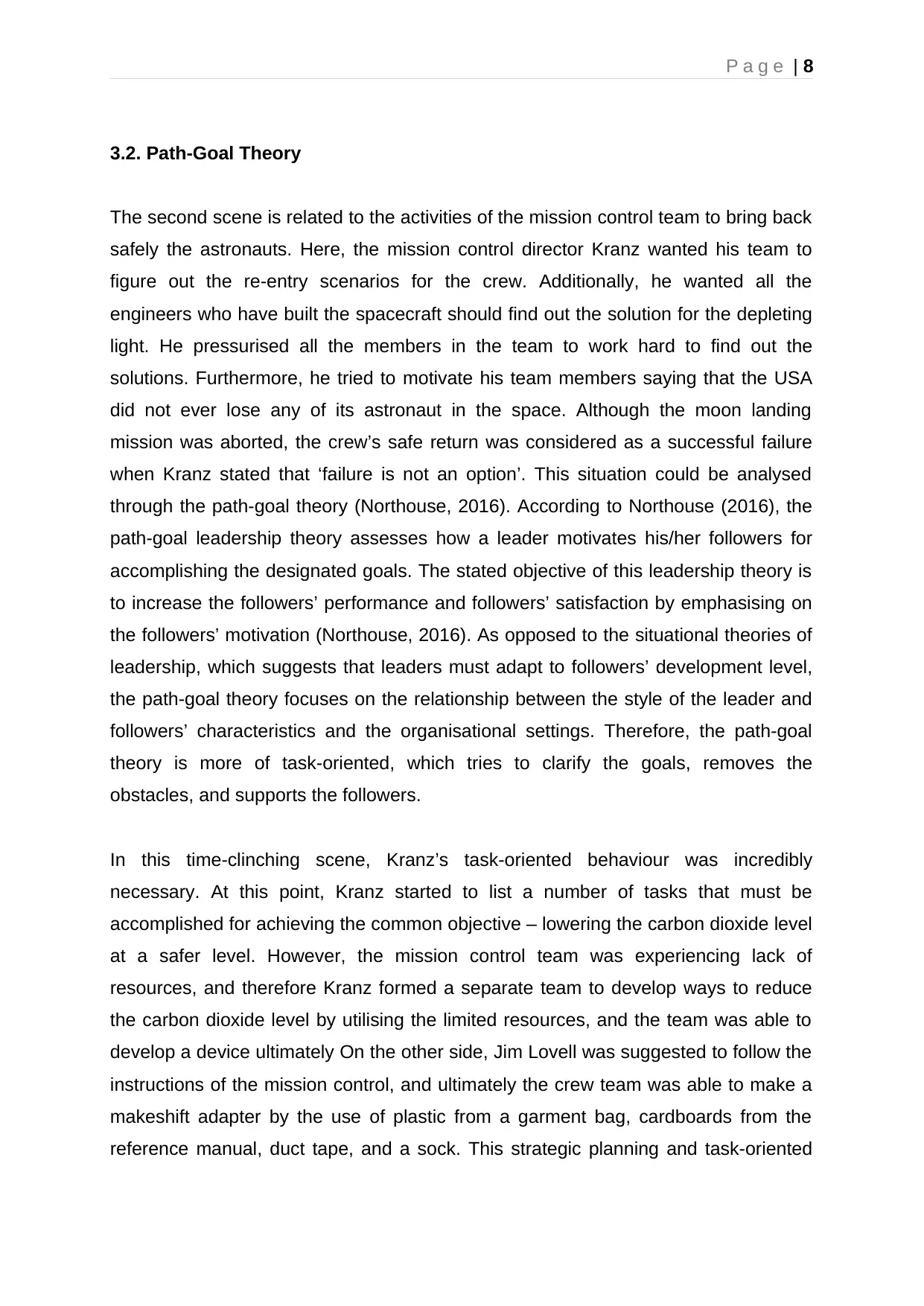
P a g e | 8
3.2. Path-Goal Theory
The second scene is related to the activities of the mission control team to bring back
safely the astronauts. Here, the mission control director Kranz wanted his team to
figure out the re-entry scenarios for the crew. Additionally, he wanted all the
engineers who have built the spacecraft should find out the solution for the depleting
light. He pressurised all the members in the team to work hard to find out the
solutions. Furthermore, he tried to motivate his team members saying that the USA
did not ever lose any of its astronaut in the space. Although the moon landing
mission was aborted, the crew’s safe return was considered as a successful failure
when Kranz stated that ‘failure is not an option’. This situation could be analysed
through the path-goal theory (Northouse, 2016). According to Northouse (2016), the
path-goal leadership theory assesses how a leader motivates his/her followers for
accomplishing the designated goals. The stated objective of this leadership theory is
to increase the followers’ performance and followers’ satisfaction by emphasising on
the followers’ motivation (Northouse, 2016). As opposed to the situational theories of
leadership, which suggests that leaders must adapt to followers’ development level,
the path-goal theory focuses on the relationship between the style of the leader and
followers’ characteristics and the organisational settings. Therefore, the path-goal
theory is more of task-oriented, which tries to clarify the goals, removes the
obstacles, and supports the followers.
In this time-clinching scene, Kranz’s task-oriented behaviour was incredibly
necessary. At this point, Kranz started to list a number of tasks that must be
accomplished for achieving the common objective – lowering the carbon dioxide level
at a safer level. However, the mission control team was experiencing lack of
resources, and therefore Kranz formed a separate team to develop ways to reduce
the carbon dioxide level by utilising the limited resources, and the team was able to
develop a device ultimately On the other side, Jim Lovell was suggested to follow the
instructions of the mission control, and ultimately the crew team was able to make a
makeshift adapter by the use of plastic from a garment bag, cardboards from the
reference manual, duct tape, and a sock. This strategic planning and task-oriented
3.2. Path-Goal Theory
The second scene is related to the activities of the mission control team to bring back
safely the astronauts. Here, the mission control director Kranz wanted his team to
figure out the re-entry scenarios for the crew. Additionally, he wanted all the
engineers who have built the spacecraft should find out the solution for the depleting
light. He pressurised all the members in the team to work hard to find out the
solutions. Furthermore, he tried to motivate his team members saying that the USA
did not ever lose any of its astronaut in the space. Although the moon landing
mission was aborted, the crew’s safe return was considered as a successful failure
when Kranz stated that ‘failure is not an option’. This situation could be analysed
through the path-goal theory (Northouse, 2016). According to Northouse (2016), the
path-goal leadership theory assesses how a leader motivates his/her followers for
accomplishing the designated goals. The stated objective of this leadership theory is
to increase the followers’ performance and followers’ satisfaction by emphasising on
the followers’ motivation (Northouse, 2016). As opposed to the situational theories of
leadership, which suggests that leaders must adapt to followers’ development level,
the path-goal theory focuses on the relationship between the style of the leader and
followers’ characteristics and the organisational settings. Therefore, the path-goal
theory is more of task-oriented, which tries to clarify the goals, removes the
obstacles, and supports the followers.
In this time-clinching scene, Kranz’s task-oriented behaviour was incredibly
necessary. At this point, Kranz started to list a number of tasks that must be
accomplished for achieving the common objective – lowering the carbon dioxide level
at a safer level. However, the mission control team was experiencing lack of
resources, and therefore Kranz formed a separate team to develop ways to reduce
the carbon dioxide level by utilising the limited resources, and the team was able to
develop a device ultimately On the other side, Jim Lovell was suggested to follow the
instructions of the mission control, and ultimately the crew team was able to make a
makeshift adapter by the use of plastic from a garment bag, cardboards from the
reference manual, duct tape, and a sock. This strategic planning and task-oriented
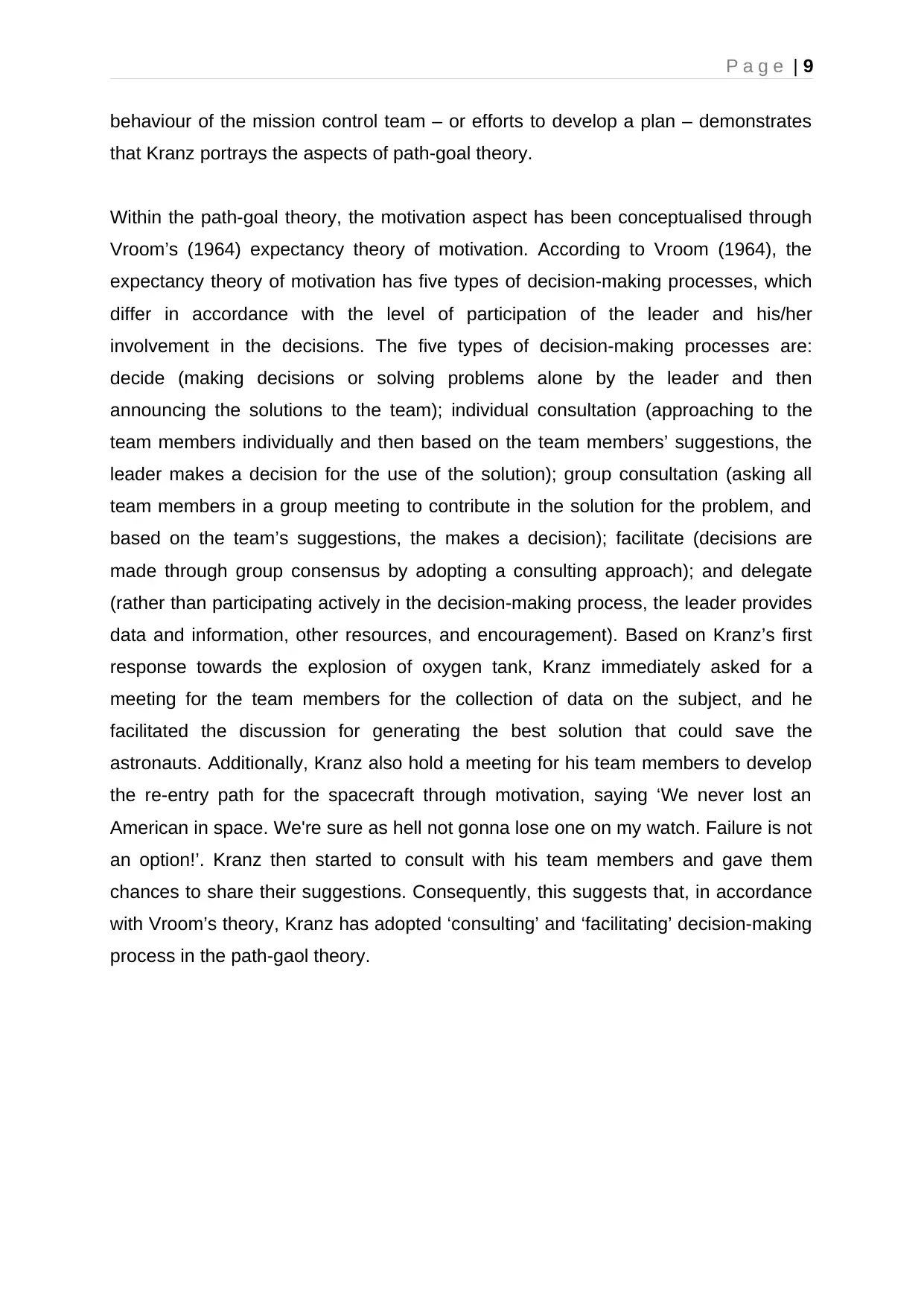
P a g e | 9
behaviour of the mission control team – or efforts to develop a plan – demonstrates
that Kranz portrays the aspects of path-goal theory.
Within the path-goal theory, the motivation aspect has been conceptualised through
Vroom’s (1964) expectancy theory of motivation. According to Vroom (1964), the
expectancy theory of motivation has five types of decision-making processes, which
differ in accordance with the level of participation of the leader and his/her
involvement in the decisions. The five types of decision-making processes are:
decide (making decisions or solving problems alone by the leader and then
announcing the solutions to the team); individual consultation (approaching to the
team members individually and then based on the team members’ suggestions, the
leader makes a decision for the use of the solution); group consultation (asking all
team members in a group meeting to contribute in the solution for the problem, and
based on the team’s suggestions, the makes a decision); facilitate (decisions are
made through group consensus by adopting a consulting approach); and delegate
(rather than participating actively in the decision-making process, the leader provides
data and information, other resources, and encouragement). Based on Kranz’s first
response towards the explosion of oxygen tank, Kranz immediately asked for a
meeting for the team members for the collection of data on the subject, and he
facilitated the discussion for generating the best solution that could save the
astronauts. Additionally, Kranz also hold a meeting for his team members to develop
the re-entry path for the spacecraft through motivation, saying ‘We never lost an
American in space. We're sure as hell not gonna lose one on my watch. Failure is not
an option!’. Kranz then started to consult with his team members and gave them
chances to share their suggestions. Consequently, this suggests that, in accordance
with Vroom’s theory, Kranz has adopted ‘consulting’ and ‘facilitating’ decision-making
process in the path-gaol theory.
behaviour of the mission control team – or efforts to develop a plan – demonstrates
that Kranz portrays the aspects of path-goal theory.
Within the path-goal theory, the motivation aspect has been conceptualised through
Vroom’s (1964) expectancy theory of motivation. According to Vroom (1964), the
expectancy theory of motivation has five types of decision-making processes, which
differ in accordance with the level of participation of the leader and his/her
involvement in the decisions. The five types of decision-making processes are:
decide (making decisions or solving problems alone by the leader and then
announcing the solutions to the team); individual consultation (approaching to the
team members individually and then based on the team members’ suggestions, the
leader makes a decision for the use of the solution); group consultation (asking all
team members in a group meeting to contribute in the solution for the problem, and
based on the team’s suggestions, the makes a decision); facilitate (decisions are
made through group consensus by adopting a consulting approach); and delegate
(rather than participating actively in the decision-making process, the leader provides
data and information, other resources, and encouragement). Based on Kranz’s first
response towards the explosion of oxygen tank, Kranz immediately asked for a
meeting for the team members for the collection of data on the subject, and he
facilitated the discussion for generating the best solution that could save the
astronauts. Additionally, Kranz also hold a meeting for his team members to develop
the re-entry path for the spacecraft through motivation, saying ‘We never lost an
American in space. We're sure as hell not gonna lose one on my watch. Failure is not
an option!’. Kranz then started to consult with his team members and gave them
chances to share their suggestions. Consequently, this suggests that, in accordance
with Vroom’s theory, Kranz has adopted ‘consulting’ and ‘facilitating’ decision-making
process in the path-gaol theory.
⊘ This is a preview!⊘
Do you want full access?
Subscribe today to unlock all pages.

Trusted by 1+ million students worldwide
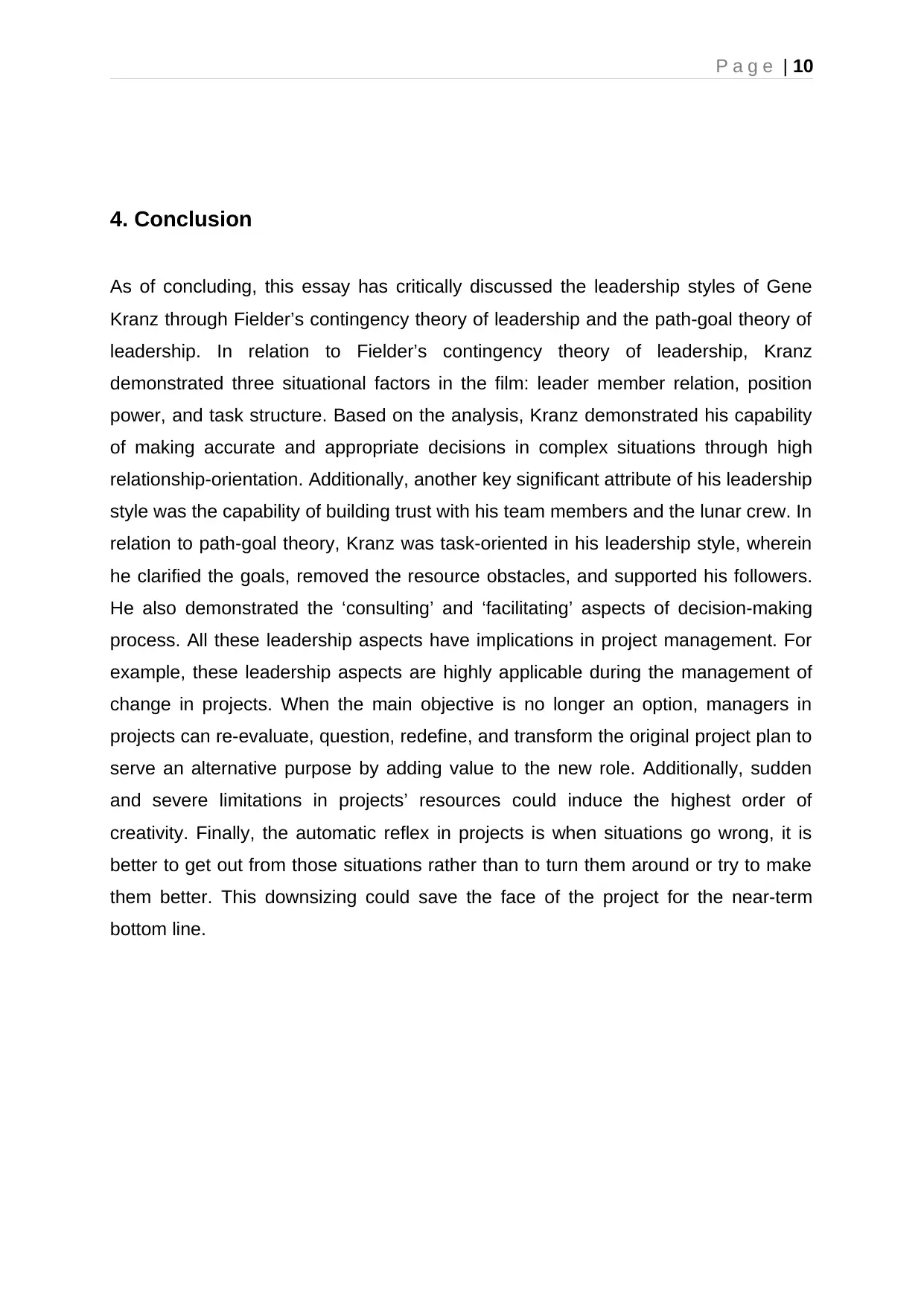
P a g e | 10
4. Conclusion
As of concluding, this essay has critically discussed the leadership styles of Gene
Kranz through Fielder’s contingency theory of leadership and the path-goal theory of
leadership. In relation to Fielder’s contingency theory of leadership, Kranz
demonstrated three situational factors in the film: leader member relation, position
power, and task structure. Based on the analysis, Kranz demonstrated his capability
of making accurate and appropriate decisions in complex situations through high
relationship-orientation. Additionally, another key significant attribute of his leadership
style was the capability of building trust with his team members and the lunar crew. In
relation to path-goal theory, Kranz was task-oriented in his leadership style, wherein
he clarified the goals, removed the resource obstacles, and supported his followers.
He also demonstrated the ‘consulting’ and ‘facilitating’ aspects of decision-making
process. All these leadership aspects have implications in project management. For
example, these leadership aspects are highly applicable during the management of
change in projects. When the main objective is no longer an option, managers in
projects can re-evaluate, question, redefine, and transform the original project plan to
serve an alternative purpose by adding value to the new role. Additionally, sudden
and severe limitations in projects’ resources could induce the highest order of
creativity. Finally, the automatic reflex in projects is when situations go wrong, it is
better to get out from those situations rather than to turn them around or try to make
them better. This downsizing could save the face of the project for the near-term
bottom line.
4. Conclusion
As of concluding, this essay has critically discussed the leadership styles of Gene
Kranz through Fielder’s contingency theory of leadership and the path-goal theory of
leadership. In relation to Fielder’s contingency theory of leadership, Kranz
demonstrated three situational factors in the film: leader member relation, position
power, and task structure. Based on the analysis, Kranz demonstrated his capability
of making accurate and appropriate decisions in complex situations through high
relationship-orientation. Additionally, another key significant attribute of his leadership
style was the capability of building trust with his team members and the lunar crew. In
relation to path-goal theory, Kranz was task-oriented in his leadership style, wherein
he clarified the goals, removed the resource obstacles, and supported his followers.
He also demonstrated the ‘consulting’ and ‘facilitating’ aspects of decision-making
process. All these leadership aspects have implications in project management. For
example, these leadership aspects are highly applicable during the management of
change in projects. When the main objective is no longer an option, managers in
projects can re-evaluate, question, redefine, and transform the original project plan to
serve an alternative purpose by adding value to the new role. Additionally, sudden
and severe limitations in projects’ resources could induce the highest order of
creativity. Finally, the automatic reflex in projects is when situations go wrong, it is
better to get out from those situations rather than to turn them around or try to make
them better. This downsizing could save the face of the project for the near-term
bottom line.
Paraphrase This Document
Need a fresh take? Get an instant paraphrase of this document with our AI Paraphraser
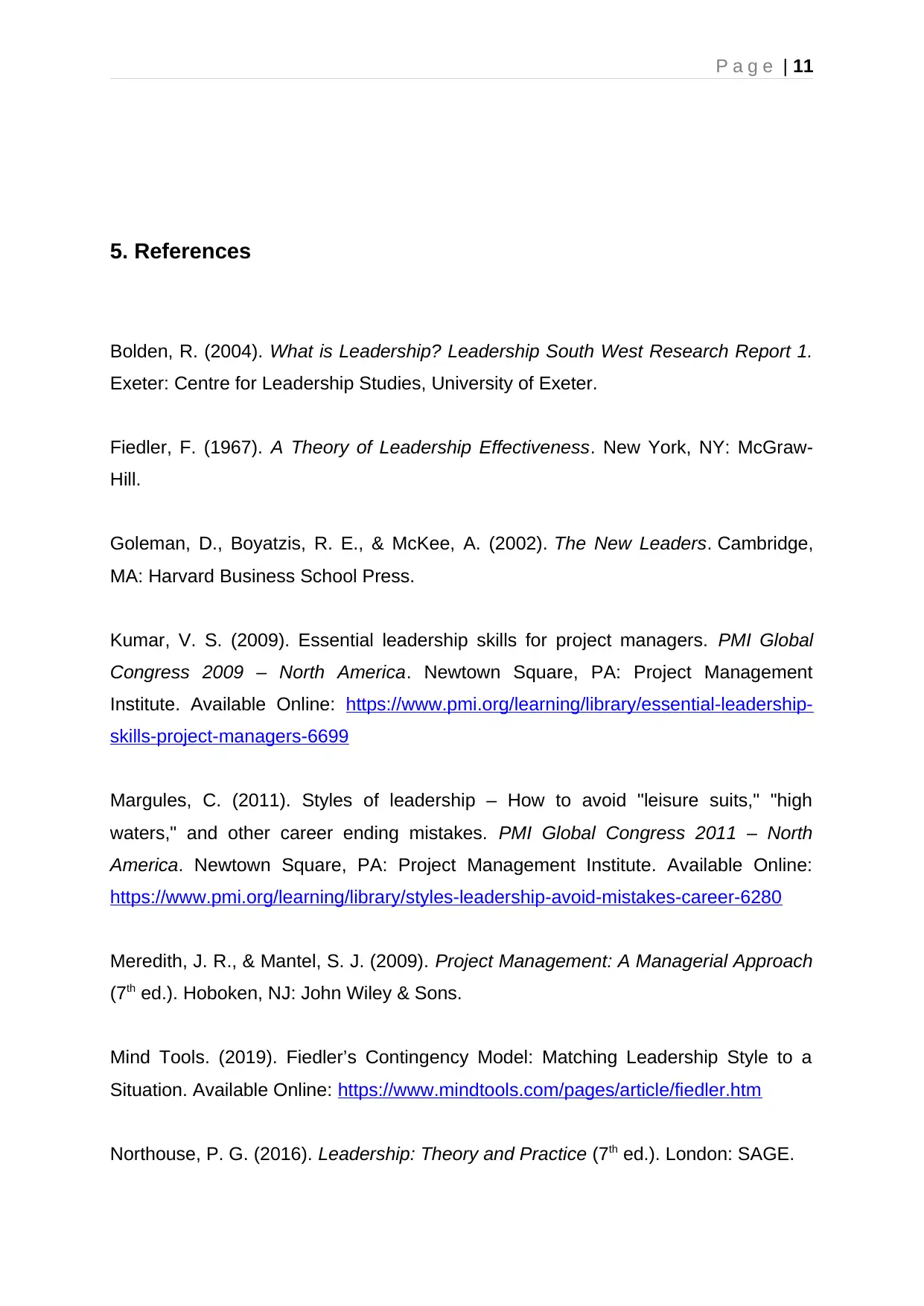
P a g e | 11
5. References
Bolden, R. (2004). What is Leadership? Leadership South West Research Report 1.
Exeter: Centre for Leadership Studies, University of Exeter.
Fiedler, F. (1967). A Theory of Leadership Effectiveness. New York, NY: McGraw-
Hill.
Goleman, D., Boyatzis, R. E., & McKee, A. (2002). The New Leaders. Cambridge,
MA: Harvard Business School Press.
Kumar, V. S. (2009). Essential leadership skills for project managers. PMI Global
Congress 2009 – North America. Newtown Square, PA: Project Management
Institute. Available Online: https://www.pmi.org/learning/library/essential-leadership-
skills-project-managers-6699
Margules, C. (2011). Styles of leadership – How to avoid "leisure suits," "high
waters," and other career ending mistakes. PMI Global Congress 2011 – North
America. Newtown Square, PA: Project Management Institute. Available Online:
https://www.pmi.org/learning/library/styles-leadership-avoid-mistakes-career-6280
Meredith, J. R., & Mantel, S. J. (2009). Project Management: A Managerial Approach
(7th ed.). Hoboken, NJ: John Wiley & Sons.
Mind Tools. (2019). Fiedler’s Contingency Model: Matching Leadership Style to a
Situation. Available Online: https://www.mindtools.com/pages/article/fiedler.htm
Northouse, P. G. (2016). Leadership: Theory and Practice (7th ed.). London: SAGE.
5. References
Bolden, R. (2004). What is Leadership? Leadership South West Research Report 1.
Exeter: Centre for Leadership Studies, University of Exeter.
Fiedler, F. (1967). A Theory of Leadership Effectiveness. New York, NY: McGraw-
Hill.
Goleman, D., Boyatzis, R. E., & McKee, A. (2002). The New Leaders. Cambridge,
MA: Harvard Business School Press.
Kumar, V. S. (2009). Essential leadership skills for project managers. PMI Global
Congress 2009 – North America. Newtown Square, PA: Project Management
Institute. Available Online: https://www.pmi.org/learning/library/essential-leadership-
skills-project-managers-6699
Margules, C. (2011). Styles of leadership – How to avoid "leisure suits," "high
waters," and other career ending mistakes. PMI Global Congress 2011 – North
America. Newtown Square, PA: Project Management Institute. Available Online:
https://www.pmi.org/learning/library/styles-leadership-avoid-mistakes-career-6280
Meredith, J. R., & Mantel, S. J. (2009). Project Management: A Managerial Approach
(7th ed.). Hoboken, NJ: John Wiley & Sons.
Mind Tools. (2019). Fiedler’s Contingency Model: Matching Leadership Style to a
Situation. Available Online: https://www.mindtools.com/pages/article/fiedler.htm
Northouse, P. G. (2016). Leadership: Theory and Practice (7th ed.). London: SAGE.
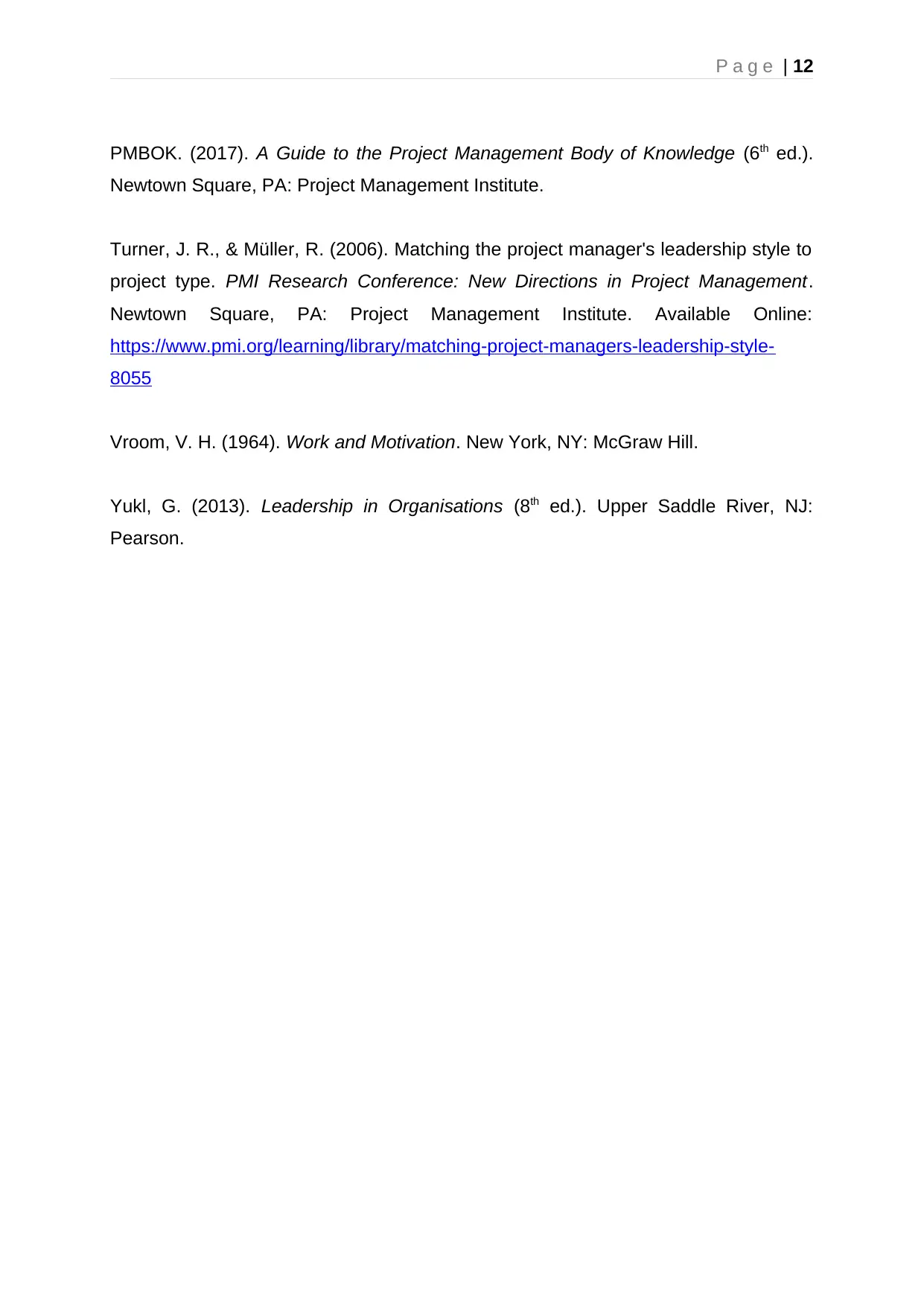
P a g e | 12
PMBOK. (2017). A Guide to the Project Management Body of Knowledge (6th ed.).
Newtown Square, PA: Project Management Institute.
Turner, J. R., & Müller, R. (2006). Matching the project manager's leadership style to
project type. PMI Research Conference: New Directions in Project Management.
Newtown Square, PA: Project Management Institute. Available Online:
https://www.pmi.org/learning/library/matching-project-managers-leadership-style-
8055
Vroom, V. H. (1964). Work and Motivation. New York, NY: McGraw Hill.
Yukl, G. (2013). Leadership in Organisations (8th ed.). Upper Saddle River, NJ:
Pearson.
PMBOK. (2017). A Guide to the Project Management Body of Knowledge (6th ed.).
Newtown Square, PA: Project Management Institute.
Turner, J. R., & Müller, R. (2006). Matching the project manager's leadership style to
project type. PMI Research Conference: New Directions in Project Management.
Newtown Square, PA: Project Management Institute. Available Online:
https://www.pmi.org/learning/library/matching-project-managers-leadership-style-
8055
Vroom, V. H. (1964). Work and Motivation. New York, NY: McGraw Hill.
Yukl, G. (2013). Leadership in Organisations (8th ed.). Upper Saddle River, NJ:
Pearson.
⊘ This is a preview!⊘
Do you want full access?
Subscribe today to unlock all pages.

Trusted by 1+ million students worldwide
1 out of 12
Related Documents
Your All-in-One AI-Powered Toolkit for Academic Success.
+13062052269
info@desklib.com
Available 24*7 on WhatsApp / Email
![[object Object]](/_next/static/media/star-bottom.7253800d.svg)
Unlock your academic potential
Copyright © 2020–2025 A2Z Services. All Rights Reserved. Developed and managed by ZUCOL.





